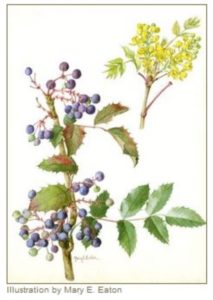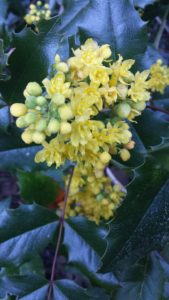Another in the “Eat Your Weedies” series! During my ethnobotany apprenticeship with Earthwalk Northwest five years ago, I chose Oregon grape, or Mahonia aquifolium as my “plant ally” to get to know intimately over the course of six months. There are several types of Mahonia and many different names: tall Oregon grape (M. aquifolium), dull Oregon grape (M. nervosa), creeping Oregon grape (M. repens), mountain grape, mountain holly, and Yerba de la Sangre to name a few.

Mahonia aquifolium is distinguished by its height (up to 10 feet!) and shiny, dark green leaves that have very sharp point like holly. You can actually eat the new growth in the spring when the leaves are coppery reddish-brown and very tender. You can also eat the bright yellow flowers. Both have a light lemony tang and are good in salads or as a trailside snack.

In mid- to late summer, flowers ripen into blue-purple berries that make a fabulous juice for jelly, wine, or syrup. The berries are quite sour and the seeds are very bitter, so they should be removed.
I used 1 1/2 pounds of berries to make two cups of juice. So it’s a lot of picking! The amount of berries will vary depending on how ripe/big the berries are. Be careful because the pointed leaves are quite sharp.
As delicious as the berries are, Mahonia is most beloved by herbalists for its medicinal qualities. It can be used as a tea (although very bitter), tincture, oil infusion or salve. The root (and some stem) bark contains berberine, a bright yellow or orange alkaloid compound which is effective against infections and has an affinity for the liver.
Mahonia is bitter, and as such it is drying, cooling, and detoxifying. Bitter herbs stimulate digestive secretions, aiding the liver in carrying out its many physiological functions including filtering blood and hormones, aiding in digestion, and removing toxins and metabolic wastes. Therefore, Mahonia is beneficial for menstrual problems, poor digestion, and skin afflictions (skin is a backup elimination system if the liver is not functioning optimally).
Mahonia is also highly effective against infections that are “hot” and “moist”, or those characterized by redness, inflammation, and/or “weepiness” (oozing – eww). Historically, Mahonia was used for chronic degenerative diseases, especially cancer and arthritis, kidney and stomach ailments, syphilis, gonorrhea, and to recover from giardiasis (aka “beaver fever”, after drinking water contaminated with the giardia parasite).
Currently, berberine is being studied extensively for its effectiveness in inhibiting MRSA and other infections that are resistant to pharmaceutical antibiotics. Other studies involving berberine have shown positive results such as inhibiting cancer cell growth, fighting inflammation, including alleviating post-operative cognitive dysfunction due to neuroinflammation, reducing cytotoxicity, and even addressing infertility for certain conditions.
Here is the basic recipe for Oregon grape juice and also Oregon grape coolers, both taken from Darcy Williamson’s The Rocky Mountain Wild Foods Cookbook. The coolers are a big hit during hot weather!
Oregon Grape Juice (to use in recipes)
Add one cup of water per one pound of stemmed berries in large pot. Simmer over medium-high heat until the berries break open and the juices begin to flow. Pour the mixture into a jelly bag or strain through several layers of cheesecloth, squeezing out excess juice and discarding solids. The juice may be frozen or bottled for later use.
Frosted Oregon Grape Cooler
Makes 4 tall drinks
2 cups French Vanilla ice cream
1 cup lemon sherbet
2 cups Oregon Grape juice
2 cups ginger ale
Whirl ice cream, sherbet, and Oregon Grape juice in blender until just blended. Stir in ginger ale and pour into chilled glasses.
I have more recipes for syrup, freezer jelly, and Oregon Grape-lavender jelly. Send a message if you’d like to try any of them!
